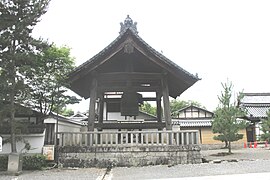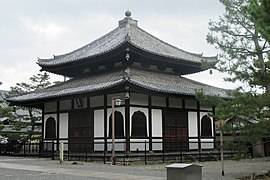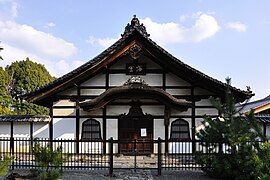Myōshin-ji
The Myōshin-ji ( Japanese 妙 心 寺 ) with the mountain name Shōhōzan ( 正法 山 ) is the main temple of by far the largest of the 15 schools of the Rinzai line of Japanese Zen and thus a reference point for 19 monasteries and 3500 temples . The complex, located in the north-west of Kyoto in Hanazono Park in the Ukyō district, unites 42 sub-temples within its walls and some outside the walls. It is registered as a "National History Trail " ( 国 史跡Kuni shiseki ).
history
In 1337, Emperor Hanazono , who had retired to monastic life after his abdication, had his adjoining palace converted into a Zen temple. He was supported by the Zen master Kanzan-Egen ( 関 山 慧 玄 ; 1277–1360). The Myōshin-ji developed into one of the largest temples in Kyōto, but never belonged to the "Big Five of Kyōto" ( Kyōto Gozan ). After most of the buildings and gardens were destroyed during the Ōnin War (1467–1477), the temple was rebuilt by the Zen master Sekkō Sōshin ( 雪 江 宗 深 ; 1408–1486), the 6th Kanchō of the temple. The temple quickly regained its size and influence, and within 150 years it had reached its current size.
The attachment
(⦿ = national treasure , ◎ = important cultural asset of Japan )
The temple is one of the best examples of a complete Zen style ( Anlage 式 ) complex with its seven buildings.
You enter the temple complex in the south through the south gate ( 南 総 門 Minami Sōmon ; 2; ◎). Next to it is the (generally closed) gate for the imperial messenger ( 勅使 門 Chokushi-mon ; 1; ◎). In the north is the north gate ( 北 総 門 Kita Sōmon ).
Central temple complex
The central temple complex contains the following buildings (see Fig. "Central system"):
- the two-story main gate ( 三門 Sanmon ; 3; ◎) from 1599,
- the Buddha Hall ( 仏 殿 Butsuden ; 4; ◎) from 1584 was redesigned in 1827,
- the teaching hall ( 法堂 Hattō ; 5; ◎), 1656, with the dragon painting (12.5 m diagonal) by Kanō Tan'yū from the 17th century on the ceiling, can be visited. Since the right eye of the dragon is exactly in the center of the circular painting, every visitor feels 'observed' in every part of the room. In the same building there is also a temple bell ( 梵 鐘 Bonshō ), which is also called Ōjikichō ( 黄 鐘 調 ; ⦿) because of its mood . The inscription Bojutsu-nen ( 戊戌 年 ) is a relative year from the 60-year cycle . It is ascribed to the year 689, making it the oldest surviving bell in Japan.
- The rest hall ( 寝 堂 Shindō ; 1656) is located between the teaching hall and the abbot area .
- The “Great Abbot's Quarter” ( 大 方丈 Daihōjō ; ◎) with its famous gate in the “Chinese style” ( 唐門 Kara-mon ; 9) was built in 1654. It has painted screens, u. a. the pair "dragons and tigers" (◎) by Kanō Sanraku , and a statue of the healing Buddha, Amida Nyorai . The Kanchō, the archabbot of the Myōshin-ji lineage of the Rinzai-shū, resides here. In this area is also the 7th building of the classical temple complex, the refectory ( 庫裏 Kuri ) from 1653.
Stand on the right side of this building
- the sutra hall ( 経 蔵 Kyōzō ; 7; ◎),
- the bell tower ( 鐘楼 Shōrō ; 8), and
- the well-preserved bathhouse ( 浴室 Yokushitsu ; 7; ◎).
Sub-temple
Within the sub-temples (usually with the ending -in ( 院 ), but also -an ( 庵 ) or -dō ( 堂 ), on the "main and sub-temple" card they are numbered from 1 to 42) the following three are that Open to visitors all year round:
- 11 Keishun-in ( 桂春 院 ),
- 29 Daishin-in ( 大 心 院 ) and
- 35 Taizō-in ( 退 蔵 院 ). This has the well-known Zen image "Hyōnen-zu" ( 瓢 鮎 図 ) by Joetsu . A copy can be seen in the temple area. The extensive gardens, through which a stream flows into a lotus pond, are worth seeing.
Are open for a limited time
- 13 Daihō-in ( 大 法院 )
- 30 Tōrin-in ( 東 林 院 )
Open under conditions
- 20 Daiyū-in ( 大雄 院 )
- 41 Jishō-in ( 慈 昭 院 )
The temples listed from here on are not open to the public.
- 1 Tenkyū-in ( 天球 院 )
- 2 rinka-in ( 隣 華 院 )
- 3 kokoku-in ( 光 國 院 )
- 4 Unjō-in ( 雲祥 院 )
- 5 Chōkei-in ( 長慶 院 )
- 6 Tenjō-in ( 天祥 院 )
- 7 Jūshō-in ( 寿 聖 院 )
- 8 Kingyū-in ( 金牛 院 )
- 9 Chishō-in ( 智勝 院 )
- 10 Banto-in ( 蟠桃 院 )
- 12 Tokuun-in ( 徳 雲 院 )
- 14 Dairyū-in ( 大 龍 院 )
- 15 Shunkō-in ( 春光 院 )
- 16 Rinshō-in ( 麟祥 院 )
- 17 Daitsū-in ( 大通 院 )
- 18 Kaifuku-in ( 海福 院 )
- 19 Yōtoku-in ( 養 得 院 )
- 21 Gyokuryū-in ( 玉龍 院 )
- 22 Tsūgen-in ( 通玄 院 )
- 23 Reun-in ( 霊 雲 院 )
- 24 Zatsuge-in ( 雑 華 院 )
- 25 Nyoze-in ( 如是 院 )
- 26 Fukujū-in ( 福壽 院 )
- 27 Shōtaku-in ( 聖 澤 院 )
- 28 Tōkai-an ( 東海 庵 )
- 31 Gyokuhō-in ( 玉鳳 院 )
- 32 Kaisan-in ( 開山 院 )
- 33 Eiban- do ( 浧 槃 堂 )
- 35 Tenju-in ( 天授 院 )
- 36 Kōbai-in ( 衡 梅 院 )
- 37 Chōgyō-in ( 長興 院 )
- 38 Yōgen-in ( 養 源 院 )
- 39 Jiun-in ( 慈雲 院 )
- 40 Ryūsen-in ( 龍泉 院 )
- 42 Shumpo-in ( 春 浦 院 )
The spiritual administration of the temple ( 宗務本所 Shumu honjo ) is connected to A is marked, the teaching site of the temple for Zen ( 花園禅塾 Hanazono Zenjuku ), as well as a guest ( 花園会館 Hanazono Kaikan ) with B .
Adjacent area of Myōshin-ji
Myōshin-ji also includes the adjacent area north of the Keifuku Denki Tetsudō railway line ( 京 福 gehört 気 鉄 道 ). There is the famous Ryōan-ji temple .
Others
Not far from the temple are the only university of the Rinzai-shū , the Hanazono University, as well as the Hanazono High School and the Rakusai Kindergarten.
photos
Remarks
- ↑ The original (⦿) is kept in the Kyōto National Museum.
literature
- Kyoto-fu rekishi isan kenkyukai (Ed.): Myoshin-ji . In: Kyoto-fu no rekishi sampo (jo). Yamakawa Shuppan, 2011. ISBN 978-4-634-24626-3 . Pages 249 to 251.
- Jørn Borup: Japanese Rinzai Zen Buddhism: Myōshinji, a living religion . Brill 2008, ISBN 978-90-04-16557-1 .
- Folder of the temple.
Web links
- Side of the Myōshin-ji - Japanese
- Page to the Zen of Myōshin-ji - English
- Myōshin-ji temple at Culture-in-Asia: Part 1 with description - Part 2 - Part 3 - Part 4 - Part 5
Coordinates: 35 ° 1 '23.41 " N , 135 ° 43' 12.66" E













